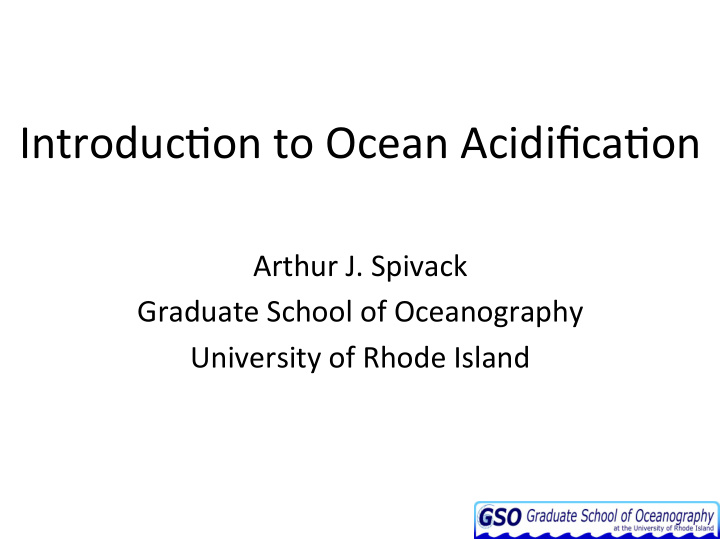



Introduc)on to Ocean Acidifica)on Arthur J. Spivack Graduate School of Oceanography University of Rhode Island
Primary Driver of Ocean Acidifica)on Increasing atmospheric carbon dioxide due to fossil fuel use.
Carbon Dioxide CO 2
Long term
Sources and Fate of Human Produced CO 2
The Ocean Acidifica)on Irony • The Good News - In the long run (> 1,000 years), the ocean and its sediment will neutralize most of the extra CO 2 humans add to the atmosphere. • The Bad News - Ocean uptake of human-produced CO 2 will, 1. lower the amount of the oceanic carbonate ion (CO 3 -2 ), an essen)al component of the shells of many organisms and, 2. lower ocean pH which will adversely affect the metabolism of many marine organisms.
What happens to carbon dioxide when it dissolves in the ocean?
What happens to carbon dioxide when it dissolves in the ocean? Fate 1: Acid Produc)on acid
A liYle chemistry background Acidifica)on- increasing concentra)on of H + . The concentra)on of H + symbolically is [H + ].
pH Scale measure of the [H + ] concentra)on pH=-log (H + ) For every 10-fold increase in acid, pH decreases by 1.
pH Scale measure of the acid [H + ] concentra)on
Common pH Values
How Ocean pH Changes with CO 2
What happens to carbon dioxide when it dissolves in the ocean? Fate 2: Neutraliza)on by carbonate ion (CO 3 -2 )
Shell Solubility and CO 2 Clams, mussels, oysters and many other organisms build shells of calcium carbonate (CaCO 3 ). This is called calcifica)on. – How much energy it takes to make a shell = depends on how much CO 3 -2 there is. – Omega (Ω) is a quan)ta)ve measure of the solubility of CaCO 3 :
Shell Solubility and CO 2 Dissolved CO 2 increases CO 3 -2 decreases Ω decreases More difficult for organisms to make shells
So what happens as we go into the future? Prediction is very difficult, especially if it is about the future. Niels Bohr
Ocean Acidifica)on: The Future • The extent of acidifica)on will depend on: – Fossil fuel use. – How much of the human produced CO 2 dissolves in the ocean.
Global Predicted Aragonite Satura)on 2100
Inconvenient Facts • In cold water, shells are more soluble. • Coastal Rhode Island waters are cold during the winter and early spring. • Result: RI coastal waters are most sensi)ve to aragonite dissolu)on in winter and early spring.
NarraganseY Bay Carbonate Satura)on Simple Idealized Model Dissolved CO 2 in equilibrium with the atmosphere 2.0 4.0 Trend due to projected Summer 3.0 increasing atmospheric CO 2 Omega Omega 1.0 2.0 1.0 Winter 0.0 0.0 1950 2000 2050 2100 2150 1950 2000 2050 2100 2150 Year Year
NarraganseY Bay and Carbonate Satura)on The real Bay is more complicated: Not in equilibrium with the atmospheric CO 2 Actual controls on Bay carbonate satura)on 1. Dissolved CO 2 of inflowing water 2. Salinity 3. Respira)on/photosynthesis balance 4. Rate of gas exchange 5. Stra)fica)on and mixing
Dissolved CO 2 of Inflow NarraganseY Bay circula)on
Respira)on/photosynthesis balance
Photosynthesis is highly influenced by the input of plant nutrients Biological produc)on, photosynthesis, is ojen s)mulated by the input of nutrients (mostly nitrate). The respira)on of plant maYer leads to the produc)on of CO 2 (and deple)on of O 2) .
Stra)fica)on and Mixing Photosynthesis here. Respira)on here. CO 2 will build up.
Regional Precipita)on Trend More precipita)on will lower salinity and carbonate satura)on
Recommend
More recommend